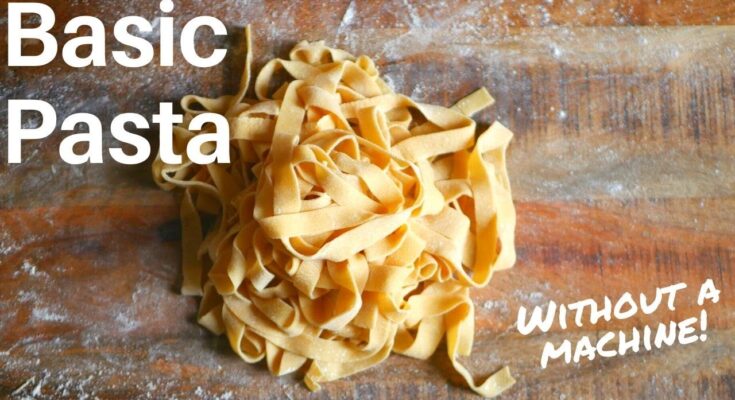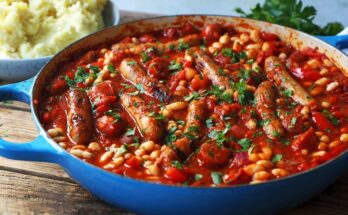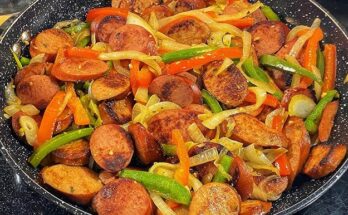Homemade Pasta Recipe: If you’ve ever dreamed of crafting your own pasta at home, you’re in for a treat! Making pasta from scratch is not only incredibly satisfying but also ensures you’re using the freshest, most wholesome ingredients.
Whether you’re aiming for silky tagliatelle, delicate ravioli, or rustic pappardelle, the process is easier than you think. Plus, homemade pasta tastes leagues better than anything store-bought.
So, grab your apron, and let’s dive into this delightful culinary journey!
Ingredients Needed
Key Ingredients for Pasta Dough
The beauty of homemade pasta lies in its simplicity. You’ll only need a handful of ingredients:
- All-purpose flour or “00” flour: For silky, smooth dough.
- Eggs: The backbone of traditional pasta, providing structure and richness.
- Optional: A pinch of salt for added flavor and a drizzle of olive oil for pliability.
Here’s a basic ratio: 1 cup of flour to 1 egg per serving. Adjust quantities depending on how many servings you need.
Tips on Selecting Quality Ingredients
- Use high-quality eggs, as they directly impact the flavor.
- Opt for “00” flour for finer, restaurant-quality pasta. If unavailable, all-purpose flour works perfectly.
- Fresh herbs, spinach, or beetroot can elevate your pasta both visually and flavor-wise.
Essential Tools
Basic Kitchen Tools
You don’t need fancy gadgets to make pasta:
- Mixing bowl or a clean countertop for mixing.
- Rolling pin for flattening the dough.
- Knife for cutting pasta shapes.
Optional Tools for Perfect Pasta
If you want a more professional finish:
- Pasta machine: For consistent thickness.
- Pasta cutter or wheel: Ideal for unique shapes like ravioli.
- Drying rack: Handy for air-drying your pasta.
Preparing the Dough
Step 1: Making a Well with Flour
Start by measuring your flour and pouring it onto a clean, flat surface or in a large mixing bowl. Shape it into a mound, then use your fingers to create a deep well in the center. This well will hold your eggs and prevent any mess.
Step 2: Adding Eggs and Mixing
Crack your eggs directly into the well. Use a fork to gently whisk the eggs, gradually incorporating the surrounding flour. Continue mixing until the dough begins to come together. If it’s too dry, add a few drops of water; if it’s too sticky, sprinkle in more flour.
Kneading the Dough
Importance of Kneading
Kneading is crucial for developing gluten, which gives pasta its elasticity and bite. Properly kneaded dough should feel smooth, slightly tacky, and elastic.
Step-by-Step Kneading Instructions
- Lightly flour your work surface.
- Gather your dough into a ball and press it with the heel of your hand, pushing it away from you.
- Fold the dough back toward yourself, rotate it slightly, and repeat.
- Knead for about 8–10 minutes until the dough feels silky and smooth.
Resting the Dough
Why Dough Needs to Rest
Resting allows the gluten to relax, making the dough easier to roll out and shape. Skipping this step may result in tough, springy pasta that’s difficult to work with.
Best Practices for Dough Resting
Wrap your dough tightly in plastic wrap or cover it with a damp towel. Let it rest at room temperature for 30–60 minutes. If you’re not using it immediately, refrigerate it for up to 24 hours.
Rolling the Dough
Traditional Hand-Rolling Method
If you’re rolling dough by hand, ensure your surface is floured to prevent sticking. Start with your rested dough:
- Divide it into smaller portions to make rolling manageable.
- Use a rolling pin to flatten one portion into a rectangular or oval shape.
- Roll from the center outward, turning the dough frequently to maintain an even thickness. Aim for a thinness where you can see your hand through the dough.
Using a Pasta Machine
A pasta machine simplifies the rolling process and ensures uniform thickness:
- Flatten a portion of dough slightly and set your machine to its widest setting.
- Feed the dough through the rollers, then fold it in half and repeat 3–4 times to make it smooth.
- Gradually adjust the settings, rolling the dough thinner with each pass until you achieve the desired thickness.
Cutting the Pasta
Different Shapes and Styles
Pasta can take on a variety of shapes, from ribbons to tubes to stuffed creations. Here are some popular options:
- Fettuccine: Long, flat ribbons perfect for creamy sauces.
- Tagliatelle: Similar to fettuccine but slightly narrower.
- Pappardelle: Wide ribbons ideal for hearty meat sauces.
- Lasagna Sheets: Wide, flat sheets for layering.
- Ravioli: Stuffed pasta pockets.
Step-by-Step Cutting Guide
- Fold your rolled-out dough lightly, dusting it with flour to prevent sticking.
- Use a sharp knife or pasta cutter to slice ribbons of your desired width.
- Unfold and separate the strands. For stuffed pasta, cut shapes and seal edges with water or egg wash.
Drying the Pasta
How to Dry Pasta Properly
Once cut, pasta can be cooked immediately or dried for later use. To dry:
- Lay the pasta strands or shapes on a floured surface or drying rack.
- Ensure pieces are not touching to avoid clumping.
- Allow them to air dry for 12–24 hours, depending on humidity.
When to Cook or Store
- Fresh pasta cooks quickly, often in just 2–4 minutes.
- For long-term storage, let the pasta dry completely, then place it in an airtight container or bag and freeze.
Cooking Fresh Pasta
Cooking Time for Fresh Pasta
Fresh pasta cooks much faster than dried. Boil a large pot of salted water, add your pasta, and watch it carefully. Cooking times vary by thickness, but most fresh pasta is ready in 2–4 minutes. Taste-test frequently to avoid overcooking.
Tips for Perfectly Cooked Pasta
- Use plenty of water to prevent sticking.
- Add pasta only after the water is at a rolling boil.
- Reserve some pasta water to adjust the consistency of your sauce.
Serving Ideas
Sauce Pairings for Different Types of Pasta
Choosing the right sauce elevates your pasta:
- Fettuccine Alfredo: A creamy sauce perfect for fettuccine.
- Bolognese: A rich, meaty sauce for tagliatelle or pappardelle.
- Pesto: A fresh, herby option that works well with spaghetti or linguine.
Creative Serving Suggestions
- Garnish with fresh herbs, grated Parmesan, or a drizzle of olive oil.
- Pair your pasta with garlic bread or a fresh side salad.
- Experiment with stuffed pasta like ravioli or tortellini for a gourmet twist.
Common Mistakes to Avoid
Troubleshooting Dough Issues
- Too sticky? Add a small amount of flour and knead again.
- Too dry? Add a drop of water and knead until smooth.
Tips to Avoid Sticky Pasta
- Dust cut pasta with flour to prevent clumping.
- Avoid overcooking; fresh pasta can become mushy if left too long in boiling water.
Storing Homemade Pasta
Short-Term Storage
Fresh pasta can be stored in the fridge for up to 2 days. Place it in an airtight container or wrap it tightly in plastic wrap.
Long-Term Freezing Tips
For longer storage, freeze your pasta:
- Arrange the pasta on a baking sheet in a single layer.
- Freeze for 1–2 hours, then transfer to a freezer bag or container.
- Cook frozen pasta directly without thawing for the best texture.
Variations and Flavors
Adding Spinach, Beetroot, or Herbs
Enhance your pasta by mixing pureed vegetables or herbs into the dough:
- Spinach: Boil and puree spinach, then mix it into the eggs.
- Beetroot: Adds a vibrant red hue and earthy flavor.
- Herbs: Chop fresh herbs like basil or parsley and knead them into the dough.
Using Alternative Flours
Experiment with different flours for unique textures and flavors:
- Semolina flour: Adds a slightly gritty texture for hearty pasta.
- Whole wheat flour: Provides a nuttier flavor.
- Gluten-free flours: Blend rice flour and tapioca starch for a celiac-friendly option.
FAQs about Homemade Pasta Recipe
Q: What ingredients are needed for homemade pasta?
A: The basic ingredients for homemade pasta are flour, eggs, and a pinch of salt. Some recipes may include olive oil for added flavor and texture.
Q: Do I need special equipment to make homemade pasta?
A: While a pasta maker can make the process easier, you can roll out the dough with a rolling pin and cut it by hand. A sharp knife or a pizza cutter works well for slicing.
Q: How long does homemade pasta need to cook?
A: Fresh pasta cooks much faster than dried pasta, typically in 2–3 minutes. Watch closely to avoid overcooking.
Q: Can I make homemade pasta gluten-free?
A: Yes, by using gluten-free flour blends specifically designed for pasta or substituting with almond or rice flour, you can create a gluten-free version.
Q: How should I store homemade pasta?
A: If you’re not cooking it immediately, you can store fresh pasta in the fridge for up to two days or freeze it for longer storage. Ensure it’s properly floured and placed in an airtight container.
Q: What are the best sauces to pair with homemade pasta?
A: Homemade pasta pairs beautifully with classic sauces like marinara, Alfredo, or a simple garlic and olive oil mix. Experiment with flavors to find your favorite combination.
Conclusion
Crafting pasta at home is a rewarding experience that brings both flavor and creativity to your kitchen. From kneading the dough to enjoying a perfectly cooked plate of fresh pasta, the process is as fulfilling as the result. With practice and experimentation, you’ll master the art of pasta-making and impress your family and friends with your culinary skills. So, grab some flour, eggs, and enthusiasm, and start your homemade pasta journey today!



